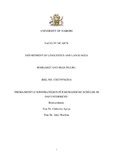| dc.description.abstract | The following study was an attempt to explain the underlying factors behind the dwindling rates of Kenyan secondary school students who learn German as a foreign language .Moreover it was intended to suggest possible motivational factors which can be applicable in the classroom and outside classrooms situations. It was expected that in the long run great contribution would be made to the development of the teaching and learning of German language in the country. This study assumed that the conditions of the language are not the same among the schools where German is taught. Secondly, it is also hypothesized that parents and teachers play a considerable role in influencing the students to drop German in form two or three. Furthermore, the study sought to find out if there is a strong correlation between the Gender of the students and their decision to drop German. In a bid to find to get relevant answers, the study employed two questionnaires which were issued to students so as to get a perspective of the students based on a number of factors which the study aimed at investigating. The schools are located in different parts of Kenya and are of diverse backgrounds. The study showed that the main challenges which contributed to most students dropping German include: Difficulty of the language, inadequate learning resources, and influence of parents, teachers and friends, poor performance, unpopularity of the language among other reasons. Furthermore the study delved into the reasons as to why other students continued learning German to higher levels where most students stated that factors such as career opportunities, interest in the language, and good performance in the language contributed to their decision. However, the least of the students were encouraged by their parents and teachers to continue learning German. Finally, two motivational theories were applied in the analysis and discussion of the findings from which possible motivational strategies that could be pertinent to the Kenyan context were also derived | en_US |



